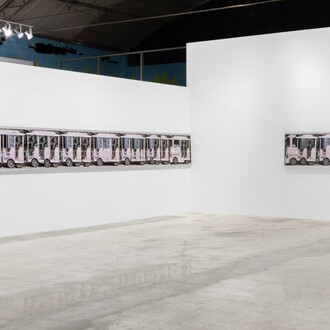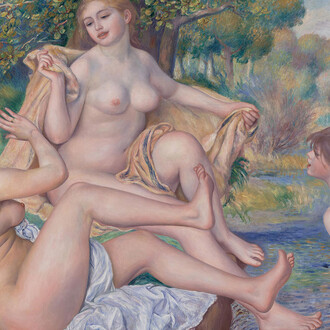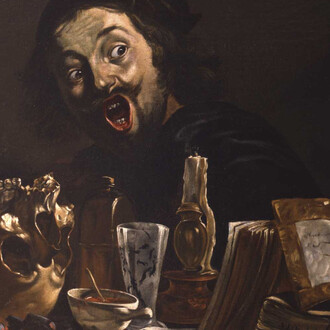Andrew Mummery is pleased to announce the opening of a solo exhibition of paintings and drawings by Louise Hopkins, and the installation of a new work by Avis Newman.
Louise Hopkins’s exhibition consists of new works made during the last four years, alongside several earlier works, including one dating back to 1998. This selection shows the rigour and consistency, yet increasing diversity, of her ongoing investigation into painting. The surfaces that Hopkins uses are both the source material and the site of her work. In her latest exhibition these surfaces include world maps, pages from catalogues advertising jewellery and household goods, photographs, and sheets of folded paper. Louise Hopkins’s work is characterised by an economy of means, but not of meaning. In her work paint becomes an agent of power in an uncertain world, a way of exploring both freedom and doubt.
Bull-Table Painting [2013] is part of an ongoing series of paintings Hopkins is making on photographs. Other works from this series have used photographs of wooden floorboards and photographs of patterned furnishing fabric as surfaces for painting. Bull-Table Painting is unusual in Hopkins’s oeuvre in that she has used herself as model. She is depicted in her studio, seemingly on her hands and knees, appearing, perhaps, to support a worktable on which stands a large black bull. However, there are various kinds of illusions here in the relationship between the paint and the photographic image.
In Setting [2012], four female figures with long dresses have been drawn over and around images of knives, forks and spoons that are part of a page taken from a catalogue advertising home tableware. There seems to be a suggestion that the figures are constructed from the implements as well as interacting with the cutlery. Who they are, which era in time they might come from, and what they represent, are ambiguous. In both works, an irreverent and dark sense of humour seems to be at play. In Bull-Table Painting and Setting, like many of the works in the exhibition, conventional means of depiction, hierarchies and modes of display are disrupted.
Since 1997 Hopkins has been painting and drawing onto maps, often world maps. The surface of the paper on which she works is also the surface of the world. These paintings could be seen to have a subtle political or ecological message. Hopkins does not respect geographical boundaries when she paints onto maps, but rather the act of painting is a way of cancelling or manipulating boundaries, be they political, geographical, or of another kind.
In the earliest work in the exhibition, World Map [1998], she has mixed paint to the same colour blue as the sea of the printed map and used it to cover all the land depicted, as well as all the text and the longitude and latitude lines, until the surface becomes a rectangle of pale blue. The landmasses of the world are visible only as a subtle trace. Is this some catastrophic inundation, a protest against nationalism and the nation state, or a search for purity? The approach to this early painting is reflected and developed in several of the recent works in the exhibition.
Quarters [2010] is another painting on a world map, again referring to the seas. Four different colours, in uneven blocks, cover the surface of the world. Is this a new flag that does not denote a country or nationality? Here Hopkins has used as a kind of ledger, or starting point, the place-names that refer to colour, such as ‘Red Sea’ and ‘Yellow Sea’. While there is logic here, it is combined with irreverence towards rules and restrictions.
Louise Hopkins lives and works in Glasgow. Recent group exhibitions have included A Picture Show at the Gallery of Modern Art in Glasgow in 2013/14. In June this year, Louise Hopkins and Carol Rhodes will have a two-person exhibition at Edinburgh Printmakers, which is part of Below Another Sky curated by Alexia Holt. From August-November this year, Hopkins will have a one-person exhibition at Linlithgow Burgh Halls, forming part of the Generation programme, a landmark series of exhibitions tracing the development of contemporary art in Scotland over the last 25 years. In 2007 Hopkins was one of the artists representing Scotland at the Venice Biennale and in 2005 a survey exhibition of her work entitled Freedom of Information was presented at the Fruitmarket Gallery in Edinburgh.
Avis Newman Iniquitous Symmetries [2014]
…………The temptation of geometry is the intellectual temptation par excellence. It is the temptation of intellectual Caesars. We must cultivate and defend particularity, individuality and irregularity – life. Human beings do not have a future in the collectivism of bureaucratic states or in the mass society of capitalism…………As a forgotten Spanish poet, Jose Moreno Villa put it with melancholy wit: “I have discovered in symmetry the root of much iniquity” Octavia Paz 1979
In the same way as other of her artworks of the last five years, Newman’s new three-part canvas work, Iniquitous Symmetries, relates to a number of the artist’s longstanding (eternal) preoccupations. Boundary, edge and framing the limits of the unframed, become a series of operations that interfere with any anticipation we might have of completion. Newman’s recent works suggests a space of fluctuations where the assemblage of parts and imaginative constructions exist as a collection of relations, a series of mobile relationships in space and time. Stretched and un-stretched canvas - hanging, stacked, leaning or overlapping - partially conceal surfaces that are in themselves layered traces. Marks made on the canvases could (or might) suggest all manner of encoded signs, diagrammatic representations, or an array of symbolic forms - a lexicon of historic images that calls into question description and assumptions of context and meaning. The suggestion is always that any arrangement is provisional and potentially available to perpetual reconfiguration. Newman has described her working process as a series of ‘configurations’ enabling the work to resist absolute fixity.
The title of the new work harks back to another, An Awful Symmetry [1990], one of a series of small boxes that Newman made in the 80s and 90s. These freestanding, or wall hung, containers housed all manner of organic substances. Newman likened the sense of these works to the intimate experience and structure of poetry, the titles often alluding to phrases from poems, or making associations with particular poets, notably Paul Celan. The works are a contemplation of the limits of language and of how it is possible, or not possible, to speak the world in a traumatic age. This idea is carried through into the recent canvas works by Newman’s use of limited colour, and her reference to qualities of colourlessness associated with drawing, and to Kandinsky’s notion of black and white as ‘silent colour’.
Avis Newman lives and works in London. Recently, her work was included in the 2013 Moscow Biennial and in On Line: Drawing Through the Twentieth Century at the Museum of Modern Art, New York [2010]. Solo exhibitions of her work have been presented at a number of international venues including the Museum of Contemporary Art, Sydney [2003], Camden Arts Centre, London [1996], Ikon Gallery, Birmingham [1995], De Appel Foundation, Amsterdam [1993] and the Renaissance Society at the University of Chicago [1988].
Mummery + Schnelle Gallery
44a Charlotte Road
London EC2A 3PD United Kingdom
Ph. +44 (0)20 77299707
info@mummeryschnelle.com
www.mummeryschnelle.com
Opening hours
Wednesday - Saturday
From 12pm to 6pm or by appointment
Related images
1 & 3 Avis Newman, Iniquitous Symmetries [2014]. Studio installation shots
2 Louise Hopkins, Setting [2012], Pencil, Correction Fluid, Ink on catalogue page
4 Louise Hopkins, Red Rings [2008], Ink and correction fluid on magazine page
5 Louise Hopkins, Quarters [2010], acrylic on world map. 50 x 70 cm
6 Louise Hopkins, Outlast [2014], Watercolour and pencil on paper
![Louise Hopkins, Bull-Table Painting [2013] ink on photograph, 20.2 x 25.5 cm](http://media.meer.com/attachments/3baf069053235ea34e45981fca9189aaf3c19e02/store/fill/545/307/5ff65dc42e7ce57c8c578c4330b40d18a5f391b01beb106ccbe3a0c6c6d9/Louise-Hopkins-Bull-Table-Painting-2013-ink-on-photograph-20-dot-2-x-25-dot-5-cm.jpg)













